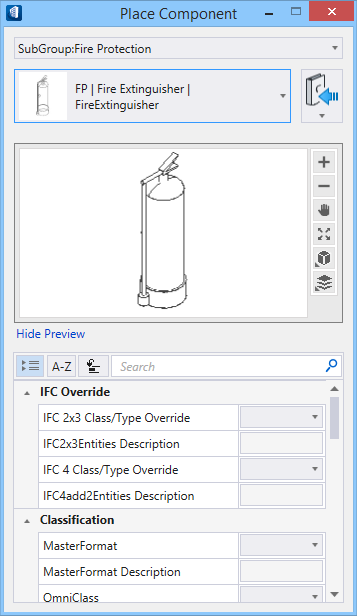Fire Protection
![]() Used to place fire protection
components and equipment used to fire protection system of plumbing
sub-discipline.
Used to place fire protection
components and equipment used to fire protection system of plumbing
sub-discipline.
Selecting a fitting from the ribbon panel activates the Place Component settings dialog, where you can manage the schema parameters (DG instance properties). Also, the contextual Placement tab appears on the ribbon, that provides placement settings options for the currently selected fitting.
The generic placement settings, along with the unique set of dimensional and data parameters from the datagroup system provide the core workflow used to accurately position mechanical components within a system.
Component categories
Fire cabinets are the boxes used to held hoses that are connected to highly pressurized water to extinguish fire in case of emergencies. The layout of the walls allows setting connection side to the fire cabinet. Besides hoses the cabinets intended to store specific fire protection equipment are landing valve, yard hydrant, breeching inlets. Active fire protection devices include fire extinguishers and fire hydrants. Surface or recessed type 2–way or 4–way breeching inlet sets allow fire engine feed water into riser systems via their fire hoses.
The stored pressure extinguishers store the firefighting agent in the same chamber as the as expellant. Depending on the agent used, different propellants are used. With dry chemical extinguishers, nitrogen is typically used; water and foam extinguishers typically use air. The rechargeable cartridge-operated extinguishers contain the expellant gas such as compressed CO2 in a separate cartridge that is punctured prior to discharge, exposing the propellant to the extinguishing agent.
Fire Protection Equipment properties give properties to set fire cabinet and fire fighting equipment.
Sprinklers are used primarily to spray water on lawns, gardens and also for recreation or as a cooling system. The sprinkler head is easily mounted at the end of pipe or at an open end of fitting connected in the plumbing system. The type decides spray pattern. The water pattern of concealed sprinkler heads is a circle.
Sprinkler head houses a Glass Bulb assembly. The dimension setting on it controls the releasing of parabolic spray pattern. Concealed pendant sprinkler heads are recessed in a ceiling and are covered with a decorative cap. The cap will fall away about 20°F prior to activation of the sprinkler. Once the sprinkler reaches its rated activation temperature, the head will drop below the ceiling. Sprinkler properties are unique to the sprinkler head.
Notable Properties
Operator Form – Sets the Valve Operator Parameters using Operator Details to either Handwheel, Wrench, Electrical or Gear, their mechanism's dimensions and the orientation details.
Connection End Type – The end conditions of ducts are set to flange, male or female connections with full dimensional control by setting the End Type property. Also, the two ends are independent, and may have different connections. For example, the value fl-2; creates a flange at End1 with size 2, and the value fe-.13 would create a female connection at the End with a clearance of .13.
Setting Type – The head position of sprinkler is set either below body cap or recessed or to result an effective sprinkling of water stream.
Flow Rate – Setting the property controls the amount of flow used to compute overall flow rate during analysis operations.
The list of fittings available in Fire Protection group is compiled in the Fire protection fitting type s topic.



